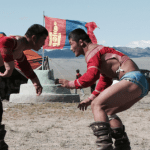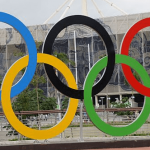 Our World
Our World  Our World
Our World  Movies and TV
Movies and TV The 10 Coolest Stars to Set Sail on The Love Boat
 History
History 10 Things You Didn’t Know About the American National Anthem
 Technology
Technology Top 10 Everyday Tech Buzzwords That Hide a Darker Past
 Humans
Humans 10 Everyday Human Behaviors That Are Actually Survival Instincts
 Animals
Animals 10 Animals That Humiliated and Harmed Historical Leaders
 History
History 10 Most Influential Protests in Modern History
 Creepy
Creepy 10 More Representations of Death from Myth, Legend, and Folktale
 Technology
Technology 10 Scientific Breakthroughs of 2025 That’ll Change Everything
 Our World
Our World 10 Ways Icelandic Culture Makes Other Countries Look Boring
 Our World
Our World 10 Ways Your Christmas Tree Is More Lit Than You Think
 Movies and TV
Movies and TV The 10 Coolest Stars to Set Sail on The Love Boat
 History
History 10 Things You Didn’t Know About the American National Anthem
Who's Behind Listverse?

Jamie Frater
Head Editor
Jamie founded Listverse due to an insatiable desire to share fascinating, obscure, and bizarre facts. He has been a guest speaker on numerous national radio and television stations and is a five time published author.
More About Us Technology
Technology Top 10 Everyday Tech Buzzwords That Hide a Darker Past
 Humans
Humans 10 Everyday Human Behaviors That Are Actually Survival Instincts
 Animals
Animals 10 Animals That Humiliated and Harmed Historical Leaders
 History
History 10 Most Influential Protests in Modern History
 Creepy
Creepy 10 More Representations of Death from Myth, Legend, and Folktale
 Technology
Technology 10 Scientific Breakthroughs of 2025 That’ll Change Everything
 Our World
Our World 10 Ways Icelandic Culture Makes Other Countries Look Boring
10 Sports No One Knows Are in the Olympics
Dive into the lesser-known corners of the Olympics, where the spotlight isn’t as bright, but the excitement is just as intense. While swimming and gymnastics steal the show, a whole world of Olympic sports is waiting to be explored.
From the lightning-fast thrills of roller speed skating to the jaw-dropping moves of breakdancing, these sports are the rebels of the Games, thriving in the shadows of obscurity. Join us on a journey where athletes defy expectations and compete in disciplines that’ll have you cheering for more. Get ready to uncover the hidden gems of the Olympics – ten sports that’ll leave you amazed and hungry for more!
Related: Top 10 Olympic Scandals
10 Skateboarding
Born out of the waves and streets of California in the 1950s, skateboarding emerged as a thrilling expression of freedom and rebellion. Initially, it was the domain of surfers seeking to bring the sensation of riding waves to land. By the 1980s, skateboarding had ingrained itself in the underground culture, synonymous with the values of individuality and pushing boundaries.
At Tokyo 2020, the world’s top skateboarders showcased their skills in two electrifying disciplines: park and street. In the park competition, athletes navigated a dynamic course filled with bowls and bends, executing gravity-defying tricks while maintaining speed and control. Judges scrutinized every aerial maneuver, rewarding creativity, height, and technical proficiency. And the course mimicked real-world landscapes. Navigating everything from stairs to handrails, competitors demonstrated their mastery of the streetscape.
Skateboarding’s Olympic debut wasn’t just about podium finishes. It celebrated the sport’s evolution, innovation, and individuality. With every flip, grind, and aerial twist, skateboarding solidified its place not just in the Olympics but in the hearts and minds of a global audience.
9 Badminton
Badminton, a sport of surprising strategy, came from the old pastime of Battledor and Shuttlecock. While popular among Europe’s elite, the game’s transition to competitive badminton is a little hazy. One compelling narrative suggests that it started at the prestigious estate of the Duke of Beaufort in Gloucestershire, circa the early 1860s, christening the sport after his grand residence, Badminton House.
Venturing beyond European shores, badminton found a fervent following in the military cantonments of India before traversing across the British colonies and beyond. Today, it’s a global phenomenon, transcending borders and cultures with its universal appeal.
Amid the graceful volleys and lightning-fast exchanges, the rules of badminton are clear-cut. Players, whether in singles or doubles, vie for supremacy across a court divided by a net, aiming to land the shuttlecock with precision or force their opponents into errors.
Since its inaugural appearance as a demonstration sport in 1972, badminton has etched its place in Olympic history. From humble beginnings, it blossomed into a mainstay event. With the upcoming Paris 2024 Olympics, 172 competitors will vie for glory across five exhilarating events, continuing the tradition of excellence that defines this captivating sport.
8 Marathon Swimming
Marathon swimming is a thrilling Olympic discipline that debuted at the 2008 Beijing Games. Its athletes face a challenging 10-km course in the open waters of seas, rivers, and lakes.
In the early days of the Olympics, all swimming events were in natural waters because pools were still on the drawing board until 1908. Marathon swimming reemerged in 1991 at the FINA World Swimming Championships, featuring a grueling 25-km showdown that lasted over five hours. The 10-km race joined the party at the FINA World Swimming Championships in 2001 in Fukuoka, Japan.
Marathon swimming is a true test of an athlete’s mettle, set against the backdrop of open water environments like seas, rivers, and lakes. Completing a 10-kilometer course demands not only physical prowess but also mental fortitude, with swimmers navigating shifting tides and currents while strategically conserving energy for the final sprint to the finish line.
The last three kilometers? Brace yourself for a nail-biting sprint finish after approximately two hours of swimming.
7 Sport Climbing
Sport climbing, born from traditional rock climbing, hit the Tokyo 2020 Games with a bang. Athletes flexed their climbing muscles in three disciplines: boulder, lead, and speed. Their final scores? A combo platter of boulder, lead, and speed determines the medal-worthy champions. Multiply those discipline rankings, and you have your scoring system. The climber with the lowest total score snags the gold.
Hold onto your carabiners because Paris 2024 is shaking things up. We’re talking two showdowns for sport climbing: a combined event featuring boulder and lead disciplines and a standalone speed event. This Olympic inclusion has turned the spotlight on sport climbing, drawing in a fresh audience eager to witness the challenges that make this sport special.
The International Federation of Sport Climbing (IFSC) plays referee, ensuring fair play with standardized rules and top-notch infrastructure for global competitions. Climbers scale artificial walls adorned with fixed anchors, putting a premium on environmental preservation and responsible climbing practices. The sport’s popularity is scaling new heights, with plans for further expansion and innovation in future Olympic Games.
6 Handball
Olympic handball kicked off in 1936 in Berlin, where it appeared as a field competition for men. After a brief hiatus, handball returned in 1952 as a demonstration sport. It officially returned to its indoor format with seven players at the 1972 Munich Olympics.
The women’s handball competition joined the Olympic lineup in 1976 at the Summer Games in Montreal, marking a significant step towards gender inclusion in the sport. From 2008 to 2020, standout players like Michaël Guigou, Nikola Karabatic, and Luc Abalo made waves for France, each clinching three gold medals and a silver at the Games.
Calling the shots from the sidelines, the International Handball Federation (IHF) governs the sport. Although handball has roots in Europe, with European nations dominating world championships since 1938, success stories have emerged from places like South Korea and Brazil.
Handball is growing globally, boasting over 27 million registered players worldwide as of 2016. Its popularity stretches beyond European borders, reaching regions like East Asia, North Africa, and parts of South America, making it a sport that transcends continents and cultures.
5 Roller Speed Skating
Roller speed skating is a high-octane sport where athletes hit mind-blowing speeds of up to 31 mph (50 km/h). This sport’s history traces back to the inaugural Roller Speed Skating World Championship held in Monza, Italy, in 1937.
Athletes tear up outdoor or indoor rinks with banked walls or closed road circuits, donning inline skates sporting a maximum of five wheels, each not exceeding 110mm in diameter. It’s all about precision and velocity.
The first taste of roller sports in the Olympics came in 1992 in Barcelona, showcasing quad rink roller hockey as a demonstration sport. Over the years, the push for Olympic recognition for roller sports bore fruit, leading to the inclusion of skateboarding in the Tokyo 2020 Olympics. The sport continues to grow fiercely competitive, magnetizing athletes and enthusiasts worldwide with its gripping competitions and physical challenges.
4 Ski Mountaineering
Ski mountaineering, affectionately known as “skimo,” is an event you absolutely can’t miss. Competitors ski uphill and downhill, skillfully navigating snow-covered mountains. The roots of this sport stretch back to prehistoric times when Nordic peoples crafted skis for efficient travel across snowy terrains.
The tale of ski mountaineering unfolds in Europe with German trailblazer Wilhelm Paulcke. In 1897, he completed the first alpine traverse, crisscrossing the Bernese Oberland on skis. This marked the birth of modern ski mountaineering, a sport that has since gained global acclaim. There have been international events in Switzerland, France, Italy, North and South America, Russia, Scandinavia, China, South Korea, and Japan.
Ski mountaineering made Olympic waves between 1924 and 1948 and is set to make a triumphant return at Milano Cortina 2026 after a 78-year hiatus. The Olympic stage will feature men’s and women’s sprint races and a mixed relay event. This Olympic comeback is a milestone for the sport and a golden opportunity for athletes to flaunt their skills on a global stage.
In the governance of ski mountaineering stands the International Ski Mountaineering Federation (ISMF), with 38 member national federations spanning Europe, Asia, and America. The sport’s unique blend of physical challenges and mountain exploration draws athletes from diverse backgrounds, including cyclists, swimmers, runners, hikers, and mountaineers.
3 Surfing
Did you know that the roots of surfing as a sport can be traced back to Peru and Polynesia? In fact, James King documented surfing in Hawaii in 1779.
The Olympic surfing dream took shape thanks to Duke Kahanamoku, a Hawaiian legend and three-time Olympic freestyle champion, who championed surfing’s cause in the 1920s. The dream materialized at the Tokyo 2020 Games, where surfers from around the globe vied for gold, silver, and bronze at Tsurigasaki Beach, Chiba Prefecture, Japan.
Crafting the wave-riding spectacle, the International Surfing Association (ISA) and the World Surf League (WSL) collaborated to shape the Olympic surfing competition’. The shortboard division witnessed 40 surfers, comprising 20 men and 20 women, showcasing their skills, marking a milestone for a sport embraced by over 25 million enthusiasts globally.
Surfing’s encore awaits at the Paris 2024 Games, with Teahupo’o in Tahiti chosen as the battleground for the surfing events. From July 27th to August 4th, the waves will witness fierce competition, underscoring the sport’s ever-growing popularity on the world stage.
2 Breakdancing
Step into the rhythm of breakdancing, also known as breaking. Breakdancing debuted at the Youth Olympic Games in Buenos Aires in 2018 and will appear at the Paris 2024 Olympics. Born in the United States during the 1970s, breaking emerged from block parties in the Bronx, New York, becoming an integral part of hip-hop culture.
The Olympic embrace of breaking signifies a turning point for this dance form, elevating it from street culture to a recognized sport. In Paris 2024, the competition format will spotlight two separate events for men and women, where 16 B-Boys and 16 B-Girls will engage in electrifying solo battles.
Judging the breaking battles involves evaluating dancers based on creativity, personality, technique, variety, performance, and musicality. A panel of five judges carefully scrutinizes each breaker’s moves, with scores adjusted based on responses to opponents and penalties for any breaches of conduct, such as mimicking moves or unsportsmanlike behavior.
The Olympic introduction of breaking has stirred varied reactions within the breaking community. Some celebrate its inclusion as an opportunity to showcase the art form to a broader audience. Others voice concerns about maintaining its authenticity and cultural roots amid its transformation into an Olympic sport.
1 Futsal
Futsal is an indoor soccer game played on a basketball-type court. It was created in the 1930s when Juan Carlos Ceriani crafted the sport in Uruguay for YMCA competitions. Quickly gaining traction in South America, notably in Brazil, futsal became the breeding ground for cultivating outstanding football skills, showcasing legends like Pele, Zico, and Socrates.
Despite its global fanfare and widespread participation, futsal is currently absent from the Olympic lineup. Enthusiasts and organizations advocating for its Olympic inclusion highlight its vast audience, popularity, and potential to draw more viewers to the Games.
The International Olympic Committee (IOC) has tread cautiously on expanding Olympic sports due to cost concerns and athletic limits. However, with futsal’s success at events like the 2018 Youth Olympics, fans hope it might find a place in future Olympic Games. While the Olympic spotlight has yet to embrace futsal, its worldwide appeal and grassroots development efforts paint a promising picture for its future.








